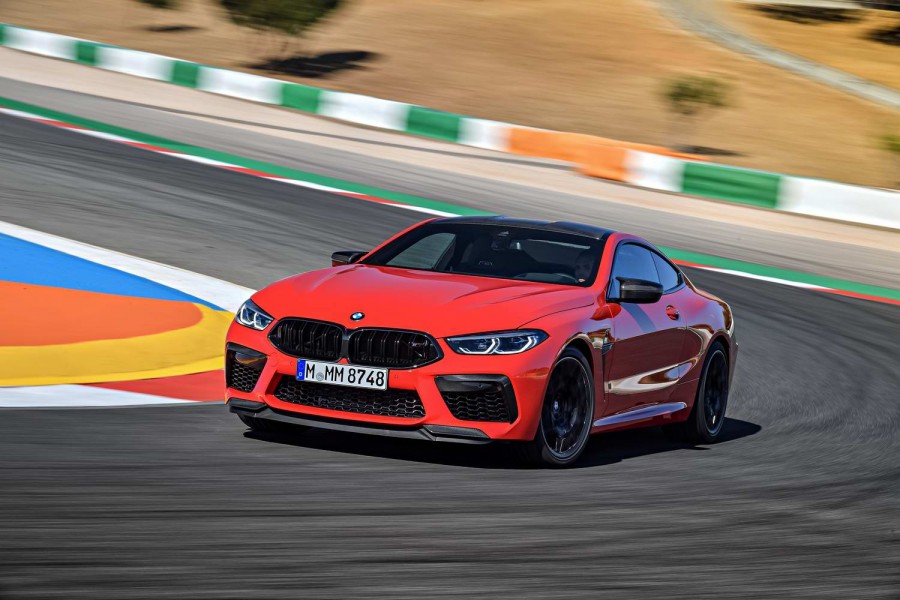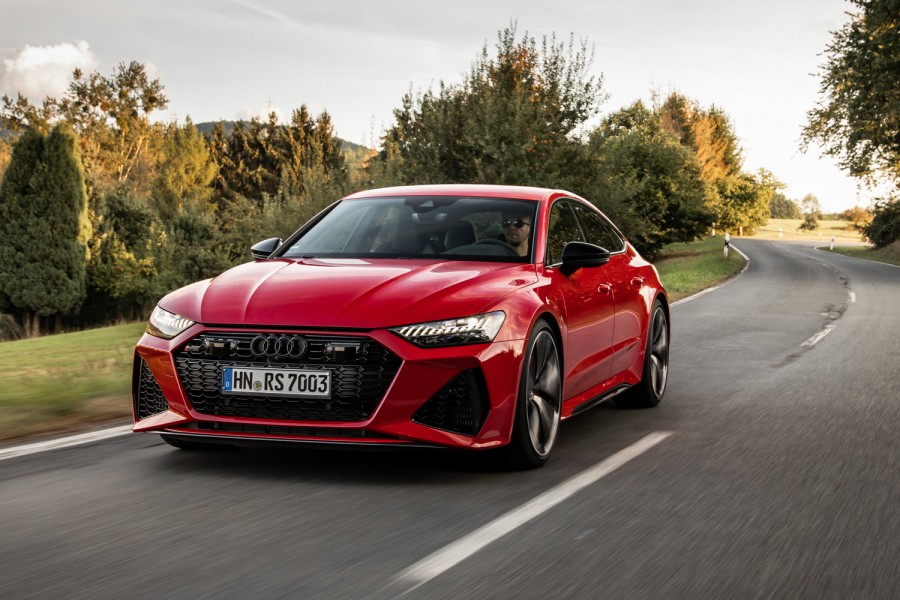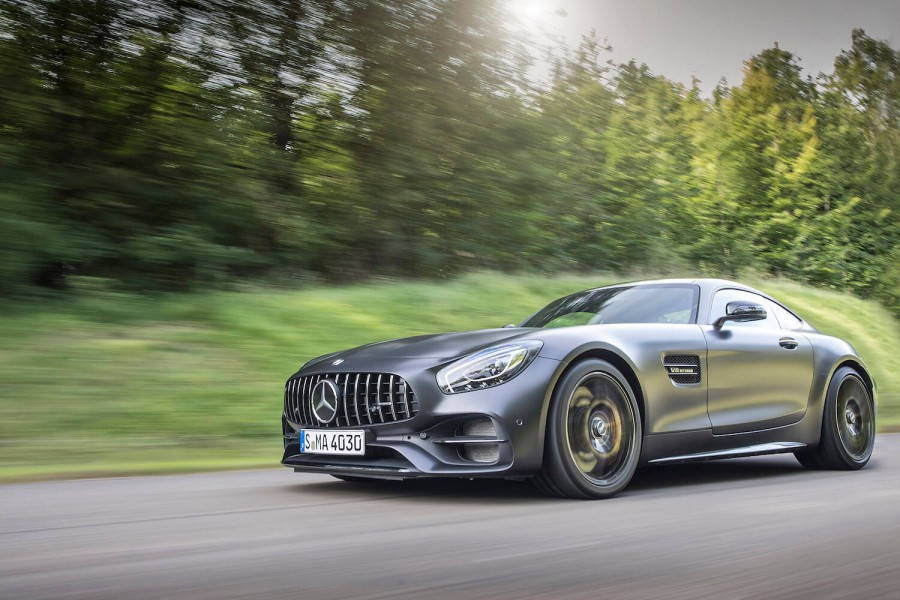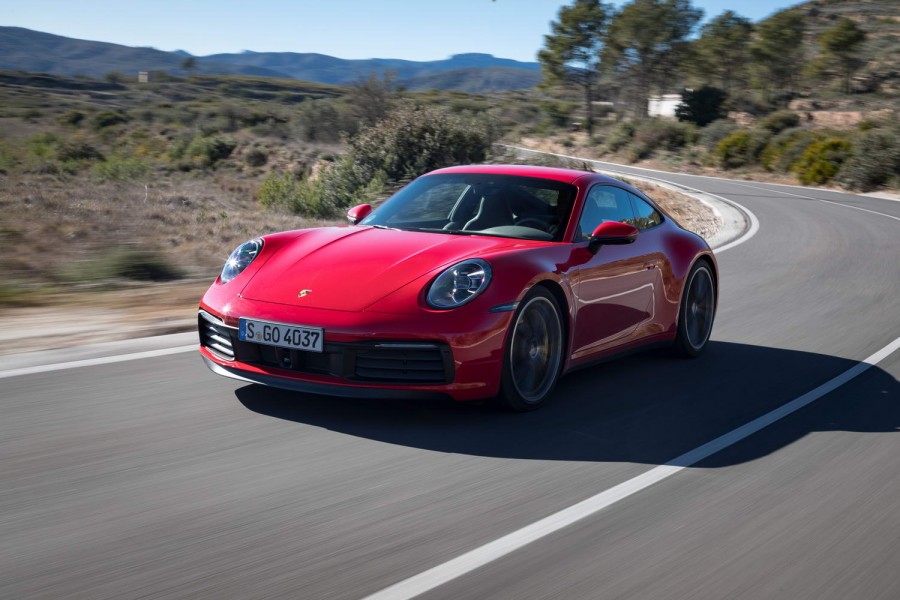The first-ever BMW M8 arrives in three body styles and, depending on market, two distinct variants. The range-topping Competition model in the two-door coupe body is the one that keen drivers will be most interested in. So is it a hardcore sports car, a Grand Tourer with superfluous performance or something else entirely?
In the metal
About a year ago, we got our first taste of the BMW 8 Series and it has to be said that the range-topping M850i xDrive version has stolen some of the new M8's limelight. Especially as it can be optionally fitted with the same 'double-bubble' carbon roof that comes as standard on the M8 (though the M Carbon exterior package - front air intakes, exterior mirror caps, M gills in the side panels, rear diffuser and rear spoiler - is an option, even on the M8). Nonetheless, and contrary to what a first glance might tell you, the M8 gets plenty of its own visual updates to differentiate it. Pleasingly, most of them are functional in nature.
Up front, for example, there's an entirely new bumper, with larger vent openings to feed air to the engine, transmission cooler and brakes. It also gets a more jutting chin spoiler. Put the M8 next to the M850i and you'll also spot the former's characteristic M take on the radiator grille, plus, the front wings are completely new. They're wider to accommodate bigger wheels and a wider track, leading to a vaguely box-arch-from-the-eighties look near the bonnet shut line. Aft of the front wheels are unique M gills and a larger outlet for the so-called Air Breathers. A set of 20-inch alloys of bespoke design is standard.
The M850i already had a seriously muscular rear end, so the M8 isn't drastically different. Saying that, the full-on M car gets an extra lip spoiler and a restyled bumper, plus the expected quad exhaust outlets in a serious looking aerodynamic diffuser. It has presence by the bucketload.
Same can be said for the M8's cabin. It builds on the high-quality interior of the rest of the BMW 8 Series range with a high level of standard specification and several bits and pieces that are completely exclusive to the M8 line-up. Figure-hugging, leather/Alcantara-trimmed sports seats set the tone with their illuminated 'M8' badges, while the centre console features lots of lacquered carbon fibre. There you'll find a new shifter for the transmission (featuring illumination, as well as buttons for 'Park' and the various Drivelogic settings), plus a big red engine start/stop button and other switchgear you'll not find in any regular 8 Series.
The (perfectly round, praise be) steering wheel looks little different to that in the rest of the range, but it comes with the now obligatory M1/M2 buttons marked out in bright red. Behind that, the digital instruments get bespoke M layouts and readings, as does the central touchscreen and excellent head-up display. The rear seats look almost as good as the fronts, tiny as they are.
Driving it
Regardless of what I've said above, and the existence of the wonderful M850i in the range already, BMW M has a real knack of giving its cars a certain feel, an immediacy, a seriousness to their performance that distances them from their relatives further down the price ladder. And so it is with the M8 Coupe. Press that bright red engine-start button and the twin-turbo V8 kicks into life with conviction. Dab the throttle and it responds keenly, with a hint of movement in the body betraying the stiff engine mounts. It certainly sounds like the real deal.
But of course it's a cinch to drive slowly at regular road speeds when needs be. Well, it is if you resist turning everything up to their sportiest settings, as that makes the throttle response a little too sharp for smooth stop-start traffic driving, while the eight-speed automatic gearbox is reticent to let go of the lower gears until closer to the redline. It's a glorious transmission whether in its smoothest, fully automatic setting or you've switched into the manual mode and gone for the fastest and most ferocious gear-changing level.
The V8's considerable power and torque are fed through that gearbox to the same core all-wheel-drive system as debuted in the BMW M5, which can vary drive infinitely front to rear and across the rear axle. The latter is done with the well-developed Active M differential, an electronically controlled unit that varies its characteristics depending on driving mode.
And owners of the M8 have a huge variety of settings to avail of if they are so inclined. There's a 'Setup' button to bring all the options up on the central screen, where the engine response and damping can be altered through three levels (Comfort, Sport and Sport Plus) for a start, while the steering and braking (more of which in a moment) have two settings. The M xDrive system, meanwhile, can be switched between standard 4WD to 4WD Sport and then 2WD. These settings are linked to the Dynamic Stability Control (DSC), though with limits. You can switch the DSC off in all modes, you get the mid-setting M Dynamic mode as the most 'restrictive' in 4WD Sport mode and there's no DSC when you take a brave pill and opt for 2WD.
BMW fitted the optional carbon-ceramic brakes to our test cars, which were mighty, but of more note is the new brake system. I mentioned above that the driver has two braking settings to choose from (Comfort and Sport); that's a first, and is thanks to a new 'integrated braking system' that reduces weight and drag on the engine, plus it is far faster to interface with the stability control system. It also allows different calibrations of the brake pedal feel, which does work, but we're not sure if we like it and, even more strangely, that feel is supposedly unaffected by the temperature of the braking components or wetness. Personally, I'd like to feel if brake fade is imminent through my foot...
A new level of customisation debuts in the M8, accessible via the new 'M Mode' button on the centre console. It's set in Road mode by default. Press the button and it switches into Sport, which alters the information and layout of the head-up display and instrumentation. This also allows the driver to disable the myriad braking and steering assistance systems (except for the Collision Warning with braking function and the Evasion Assistant). Hold down the M Mode button and the Track setting is put in place. This disables all the assistance systems and even turns off the infotainment screen and audio system for minimum distraction.
That's precisely what you'll want if you happen to have a challenging road or empty racetrack in front of you, as mastering the considerable performance of the M8 takes concentration. That engine is a monster, producing its 750Nm of torque from just 1,800rpm and hurling the big coupe toward the horizon with a rousing bellow at seemingly any speed in any gear. The xDrive system helps it screech away from a standstill and, 3.2 seconds later, hit 100km/h, but it's the way this car piles on silly speed when there are already big numbers showing on the speedo that defines its brawny performance.
Nonetheless, the M8 is not a one-trick dragster. BMW M has made big changes to the chassis and while we're not surprised to find that it can lap a rather senior racetrack (such as Portimao in Portugal) with poise, balance and huge speed, this test also served to illustrate how BMW M has managed to make the M8 engaging to drive. There's a surprising amount of information transmitted from the front tyres to your hands through the steering wheel, allowing you feel and gauge the limits through corners of all speeds. This in turn gives you the confidence to really lean on the car. That's not to say that it benignly goes where you point it, either, as it's a playful chassis that likes to move around.
In such conditions, the 4WD Sport setting is ideal, as the system clearly sends a big proportion of the engine's output to the rear axle. Hence, it largely feels rear-driven and will allow a certain amount of showboating on opposite lock (if you have the space and safety of a track, I might add) before more drive is sent to the front wheels to aid traction. Even then, it's a smooth transition from apex to corner exit, and highly satisfying.
We did try the 2WD mode as well, and it's a bit of a giggle if, ultimately, pointless in this car. Unless your intention is to vaporise tyres at every given opportunity, of course.
What you get for your money
Obviously, the BMW M8 is expensive to buy, but so are all cars that could be considered to be rivals. It wants for nothing in terms of equipment on board, but of course there's a long and tempting list of options, too, including eye-catching paint colours.
Summary
The BMW M8 Coupe has few directly comparable rivals in the market. It's a good deal cheaper than the seriously high-end, high-performance GT cars from the likes of Aston Martin and Bentley, yet Audi and Mercedes don't really make equivalent cars. Nevertheless, we're loathe to paint the M8 as purely a GT, as its performance and chassis can play the sports car role just as convincingly. Thanks to the vast array of driving options, it's up to the owner which version of the car they get behind the wheel of on any given day. The lucky feckers.


























































